LB701: Insects Live in an Infrared World
David Noel
<davidn@aoi.com.au>
Ben Franklin Centre for Theoretical Research
PO Box 27, Subiaco, WA 6008, Australia.
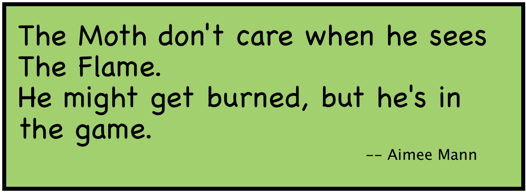
How Animals Smell
We know a fair amount about how an animal's sense of smell operates, although there is still much to be discovered. The olfactory system, or sense of smell, is the part of the sensory system used for smelling (olfaction). Most mammals and reptiles have a main olfactory system and an accessory olfactory system. The main olfactory system detects airborne substances [1].
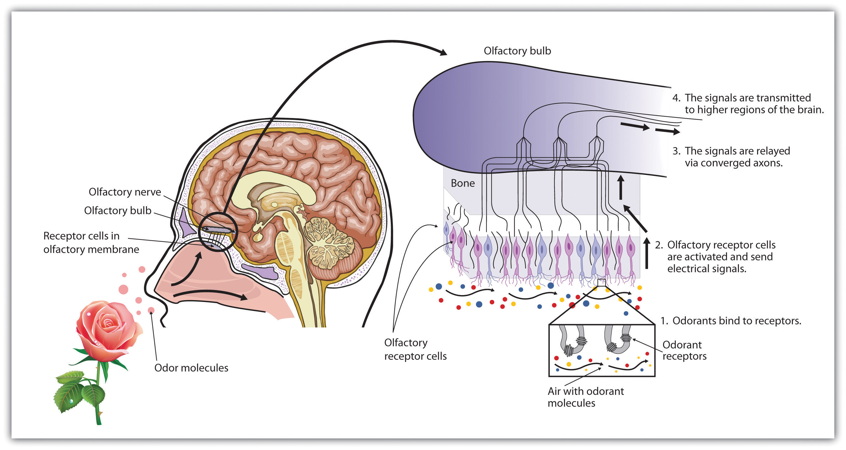
Fig. LB701-F1. The mechanism of smell. From [2].
Basically, smelling occurs when molecules of certain substances (for convenience called "odour molecules") come into contact with the mucous lining of the nostrils (the olfactory epithelium). This surface contains "olfactory receptor cells" which may be activated by odour molecules to fire off electrical signals along nerve cells connected with the brain.
The Mucous Lining
The mucous lining, the layer of mucus which coats the inside of the nostrils and some adjacent parts (also called the olfactory membrane), is one of the 2 vital parts of the smell system. It is not a minor part of the metabolism; every day, the average human body produces over 1 kilogram of nasal mucus.
Mucus is made by mucosal glands that line the body's respiratory tract, which includes the nose, the throat and the lungs [4]. When things are working properly, your body is pretty good at getting rid of it. The mucus in your nose, for example, is moved to the back of the nasal passages and then into the throat by tiny hairs on nasal cells called cilia. And from there, you gulp it down. That's right -- you're swallowing your snot all day, every day. You just don't notice it [4].
And when you consider that an average human takes in about 2 kg of food and about 2 litres of liquid a day, mucus production is a major activity. Of course, the mucus is recycled, it's not used up. For a human, the mucous lining is a very important part. We know that it is vital for smelling -- in my view, it is also very important for protection against invading germs and the such, a part of the immune system.
Gas-Liquid Chromatography
The mammalian smell system has some similarities with a method of chemical analysis called Gas-Liquid Chromatography. In GLC, an inert gas such as nitrogen is fed through a system of columns which have liquid or semi-liquid linings, similar in principle to those in the nasal passages.
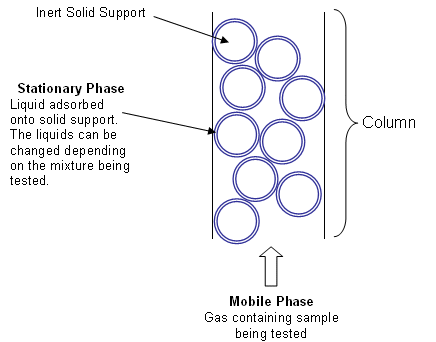 .
. 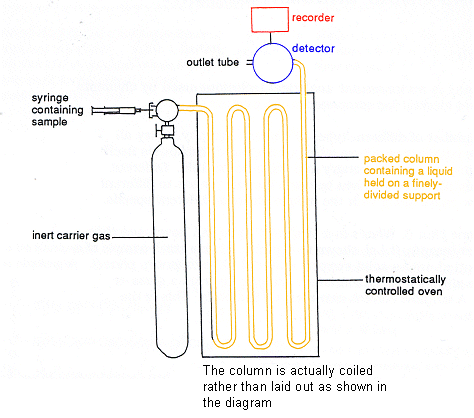
Fig. LB701-F2. Liquid-lined columns and inert-gas flow in a gas-liquid chromatography setup. From [3].
When the GLC setup has a steady flow of inert gas passing through it, a small sample of the substance to be analyzed (usually a mixture) is injected into the flow with a syringe. The essential feature of GLC, and of other chromatography techniques, is that different molecules pass through the setup at different rates -- movement through the liquid linings "smears out" the different components over time.
The timing in arrival of different components at the outlet of the GLC can be detected and recorded with suitable instruments. Generally speaking, for a given GLC setup, the time of arrival of a given component will be the same, so the setup will give the amount of each component with an identified signal. Obviously, the nature of the liquid in the columns and the nature and speed of the carrier gas can be varied to pick up different ranges of components.
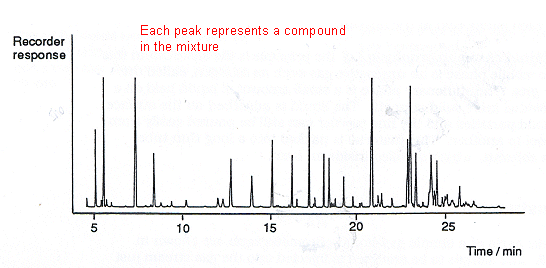
Fig. LB701-F3. Recorder response pattern from a GLC setup. From [3].
A typical recorder pattern from a GLC is as shown. In this setup, some components appeared at the outlet within 5 minutes of injection, others took more than 25 minutes to appear. Generally, volatile (light) substances pass more rapidly. In this example, about 20 different major components and a similar number of minor components were detected in the mixture.
How Smelling is analyzed in the Brain
While a GLC analyzer has just one detector, the mechanism by which odours are analyzed in the brain is enormously more complex. Signals from the scent receptors in the mucous lining go first to the two Olfactory Bulbs which lie above the nostrils.
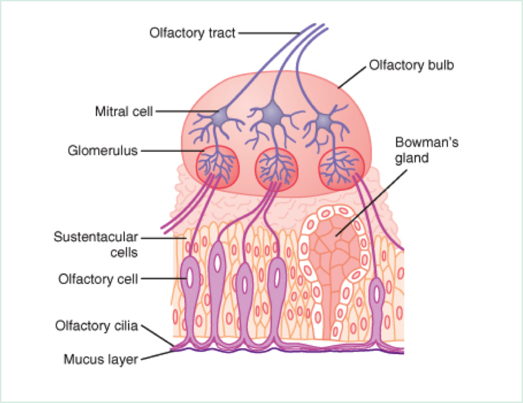
Fig. LB701-F4. The Olfactory Bulb. From [5].
A lot of processing of these signals takes place in the Olfactory Bulbs. The outputs from this processing are then passed on to other parts of the brain, some for immediate action, others for longer-term analysis and recording (memory). In higher mammals, some immediate reactions to smell are triggered in the more primitive part of the brain, and would be classed as instinctive.
The nature of these connections from the olfactory bulbs to other parts of the brain is quite involved. According to [1], the olfactory bulb connects to numerous areas of the amygdala, thalamus, hypothalamus, hippocampus, brain stem, retina, auditory cortex, and olfactory system. In total it has 27 inputs and 20 outputs.
So the decoding of smells is a complex process, perhaps as complex as that of sight. While some reactions may be thought of as "built in", as when a baby antelope shies away from the scent of a lion it has never seen, other reactions will be learned through experience, as good or bad.
For some types of animal, such as dogs, smell can be vitally important. Here are some extracts from The Dog's Amazing Nose! [6].
"The Olfactory Bulb is a bulb of neural tissue within the dog's brain. It is located in the fore-brain and is responsible for processing scents detected by cells in the nasal cavity. It is approximately 40 times larger in dogs than in humans, relative to total brain size. A human's brain is dominated by a large visual cortex whilst a dog's brain is dominated by the olfactory cortex. The Olfactory Bulb accounts for one eighth of the dog's brain.
The Olfactory Bulb is extremely important to the dog due to its function of processing scent. Scent information travels from the Olfactory Bulb to the limbic system, which is the most primitive part of the brain (dealing with emotions, memory and behaviour). It also travels to the cortex (the cortex is the outer part of the brain that has to do with conscious thought). Because olfactory information goes to both the primitive and complex part of the brain it affects the dog's actions in more ways than we may think.
A dog's sense of smell is probably more important to it than any other sense, with the possible exception of touch. The sense of smell and the sense of touch are the predominant senses for a dog and they are in place and fully functioning at birth, unlike hearing and sight, which develop later, and taste, which although present at birth and connected to smell, takes a back seat.
A dog has around 220 million scent receptors in his nose -- that's 44 times the number of receptors in our own human nose. The bloodhound exceeds this standard with nearly 300 million scent receptors!"
Bloodhounds, the Kings of Smell
It will be apparent that for a better sense of smell, you need a bigger area of olfactory membrane containing more receptor cells, and bigger olfactory bulbs to process the increased amount of information. This is clear when the dog breed with the best sense of smell, the bloodhound, is compared with other breeds, or with humans. Here are some extracts from [7].
"The back of a dog's nasal cavity contains a membrane called olfactory mucosa. The olfactory mucosa membrane helps trap scents. The bigger the nose, the bigger the membrane. The membrane's size varies among breeds, from 45 cm2 to almost 390 cm2. Once the scent molecules are trapped by the olfactory mucosa, smell- or scent-detecting cells process the scent molecules and send the information to the brain".
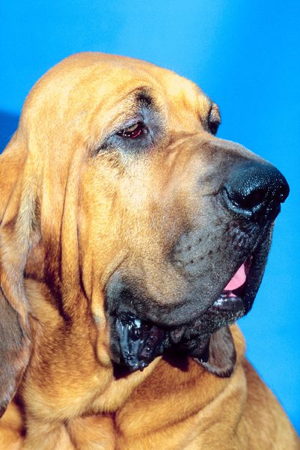
Fig. LB701-F5. The bloodhound is famous for his developed sense of smell. From [7].
"The bigger the dog's nose, the more smell-detecting cells it contains. The best noses for smell-detecting activity are long, wide noses because they can hold the most scent-detecting cells. The size of the dog doesn't matter as much as the size of the nose. A beagle, for example, has just as many smell-detecting cells as a German shepherd.
The top scent-smelling dog is the bloodhound, a breed with a large and wide nose. That breed has 300 million scent-detecting cells, which is why bloodhounds have traditionally been used as hunting companions and to track humans both in search-and-rescue operations and to catch criminals. Besides the long, wide nose that helps the bloodhound pick up scents easily, the long neck allows the breed to follow a scent with the nose to the ground without becoming fatigued in the shoulders.
The bloodhound has the most scent-detecting cells. His nose might not be the longest of all the breeds, but it is the most massive; it's long and wide. Combine that with the droopy ears that sometimes act to direct odors to the nose during tracking and trailing and with the neck that allows the bloodhound to remain with his nose to the ground for a long time, and you have a smelling machine. Compare the bloodhound with the German shepherd, who has 225 million scent-detecting cells, and the dachshund, with 125 million. People have only 5 million of them. Even a flat-nosed dog has a better sense of smell than humans, and likely has close to 100 million scent-detecting cells".
How Insects detect "Odours"
Insect physiology is totally unlike that of a mammal, but insects too can apparently detect substances at considerable distances. Under the topic "Insect Pheromones", cases are described whereby male insects can "pick up the scent" of a female insect as far as 11 kilometres away [12].
Moreover, the amount of scent produced is generally stated to be extremely little. In [12] it notes that "Moths are popularly characterized by two remarkable traits associated with chemical communication in a sexual context. First is the apparent ability of males to detect and respond to female sex pheromones over impressively long distances, including one anecdotal report of 11 km in an emperor moth, even though females typically produce very small quantities of sex pheromone in the order of nanograms or even picograms". (A nanogram is a billionth of a gram, and a picogram is a trillionth of a gram).
So, how do insects manage such long-range detection? In an article How do Insects Smell?, Debbie Hadley gives a typical explanation [8].
"Insects don't have noses the way mammals do, but that doesn't mean they don't smell things. Insects are able to detect chemicals in the air using their antennae or other sense organs. An insect's acute sense of smell enables it to find mates, locate food, avoid predators, and even gather in groups. Some insects rely on chemical cues to find their way to and from a nest, or to space themselves appropriately in a habitat with limited resources.
Insects produce semiochemicals, or odor signals, to interact with one another. Insects actually use scents to communicate with each other. These chemicals send information on how to behave to the insect's nervous system. Plants also emit pheromone cues which dictate insect behaviors. In order to navigate such a scent-filled environment, insects require a fairly sophisticated system of odor detection".
So some insects have an extremely powerful detection system, much more powerful than anything known in the animal world. How is this possible? Let's look at the standard explanation, and see what bits are reasonable, and what bits defy commonsense.
First, insect detection systems are usually tied up with possession of elaborate antennas. There seems no doubt that the properties of their antennas, which may be extremely elaborate, govern insects' abilities to pick up signals from afar. In [12] it mentions that "males of many species have beautiful and conspicuous feathery antennae".
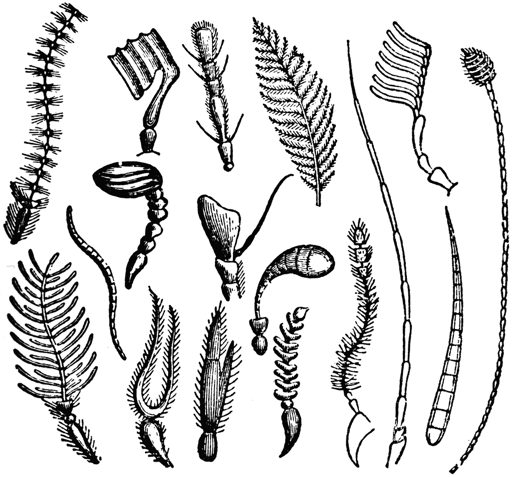
Fig. LB701-F6. Some types of insect antenna. From [11].
Some scans of insect antennas have been made at very high magnification, using electron microscopes. These antennas may have intricate detail, with blends of long and short "hairs" of various thicknesses. Below is shown some of the detailed structure of a mosquito antenna.
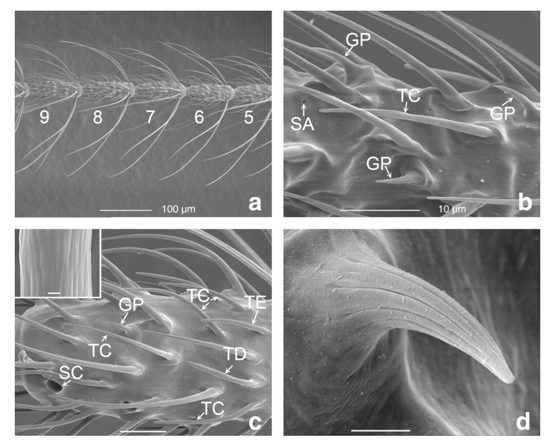
Fig. LB701-F7. Electron-microscope scans of mosquito antennas. From [10].
How Antennas work
While antennas are certainly at the base of insect sensing systems, these clearly are totally unrelated to the smell detection systems of mammals. To obtain good smell detection, mammals have developed two main parts, a mucous membrane containing huge numbers of smell receptors, and olfactory lobes to process signals from the smell receptors and pass on processed outputs to other parts of the brain. Neither of these parts is present in any way in insects. Insect signal detection very obviously must operate with quite different mechanisms.
We are familiar with the term "antenna" in radio and telecommunication systems, where antennas are used both to send out broadcast or beamed electromagnetic signals, and to receive such signals at a point of use. It is a feature of antennas that they have physical components of similar size to the wavelengths of the electromagnetic waves they handle. That is why, for example, home television receiving antennas have become smaller as television stations move to shorter-wavelength signals.
And so also with insect antennas. Their complex and varying parts are the right size to pick up infrared electromagnetic radiation, radiation of longer wavelength and lower energy than the red light which human eyes can detect. While Dogs live largely in a world of smell, and Humans in a world of visible light, Insects live in an infrared world.

Once the concept of Insect Infrared Sensing (IIS) is grasped, so much of what has been puzzling in the past becomes clear. On the old Pheromone Model, a tiny production of a chemical compound could be "smelled" up to 11 kilometres away. And smelled by a creature without the sensitive mucous membrane and brainpower of a mammal.
But in the Infrared Sensing Model, information is being passed by electromagnetic waves, like light but a of a slightly longer wavelength. The infrared waves travel at the speed of light, and can be detected at great distances. A human being can detect visible light from the Great Andromeda Galaxy with the naked eye, and that light has travelled for some 2.3 million light-years, so the idea of detecting infrared light from 11 kilometres away is easy to accept.
What we call "infrared" actually occupies a much wider band of the electromagnetic spectrum than does visible light -- some 40 times as wide. However, the "far infrared" portion is low-energy radiation which we perceive as heat, and this is given off by all matter at "room temperature", and would be of lesser use for passing signals.
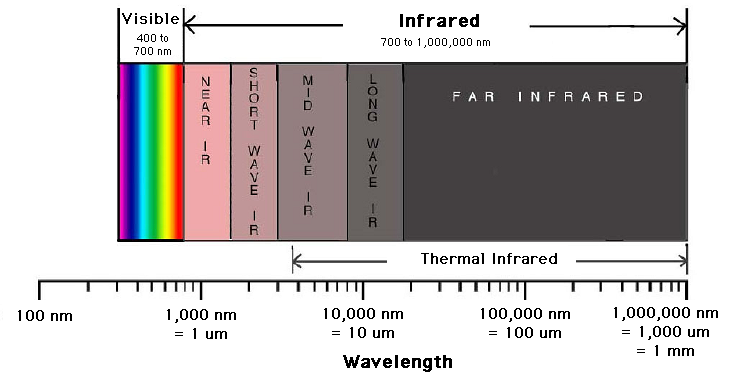
Fig. LB701-F8. The visible and infrared light spectrum. From [13].
It's worth commenting on the sizes of the infrared wavelengths and radiating structures involved. If you look back at the mosquito-antenna photos, at the bottom of each picture is a small white bar. In the first photo, this bar is marked 100 μm, in the second and third the bar is 10 μm, in the fourth 1 μm. Here "μm" means micron or micrometre (one-millionth of a metre), so the longest "hairs" are about 200 microns long, the short horn about 5 microns long.
Turning now to the visible-infrared spectrum shown just above, on the wavelength scale at the bottom, the near-infrared panel is marked "1 um", the long-wave infrared "10 um", and part way into the far infrared, "100 um". Here "um" also means micron. Since the wavelengths received or omitted by antennas are similar to the sizes of the physical structures involved, this tells us that mosquito antennas are sensitive to wavelength from short-wave infrared (around 5 microns) to the mid-far infrared (around 100 microns).
It suggests also that as regards the far-infrared bands contain the normal thermal emissions which we perceive as heat, these will tend to drown out the longer waves which the mosquito can distinguish during the heat of the day. And just as we can only see the stars in the sky when daylight is withdrawn, so some Infrared emissions will only be useful to insects during the night. This explains why moths, mostly working at night, have elaborate feathery antennas, while butterflies, active during the day, do not.
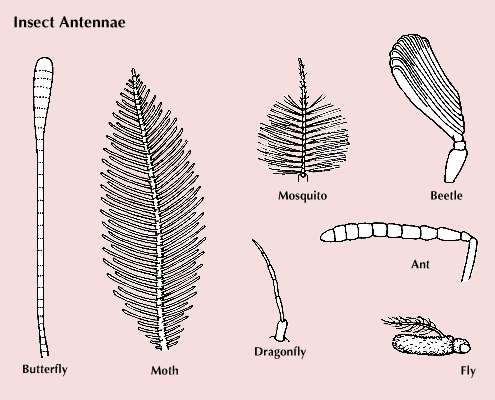
Fig. LB701-F9. Antennas of moths, butterflies, and other insects. From [13].
The concept that insect communication is by infrared, rather than pheromones, is not unknown, although very seldom acknowledged.
As an example of previous disclosures of this by Philip Callahan, as far back as 1965, this extract from an article about why moths suicide in candle flames [9] is interesting.
"The idea that antennal sensilla of insects are dielectric waveguides or resonators to electromagnetic energy presumes the emission of such energies from insect pheromones and host plant scents. Many organic molecules chemiluminesce in the far infrared and particularly in the 7--14 μm and 15--26 μm windows. Luminescence from the insect pheromone (sex scent) was predicted by P. S. Callahan in 1965. The prediction was based on the form, arrangement, and dielectric properties of the moth antenna sensilla (spines) -- in short, on morphology and antenna design alone. The male cabbage looper moth is attracted to the acetate molecule given off by the female. The exact same coded far infrared lines (17 μm region) are emitted by a candle flame. The male moth is highly attracted to and dies attempting to mate with the candle flame".
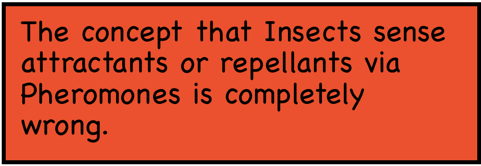
There is another far-reaching implication of the Insect Infrared Sensor Model. Antennas typically work both in receiving and transmitting, the functioning of a given antenna depends on how it is connected to power. Instead of producing so-called pheromones, a female insect produces an infrared wave pattern which is picked up by the male. No complex chemical-production process in the female is needed.
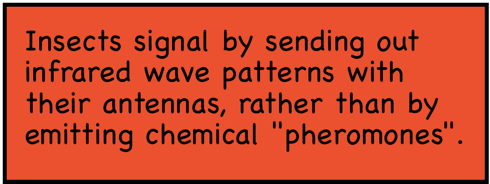
Practical applications of the Insect Infrared Sensing Model
Insect Infrared Sensing (IIS) technology will have enormous practical and commercial applications. It operates without any significant use of brainpower in the insect. If an infrared signal matching the insect's antenna structure is received, it's like a switch -- the insect has no choice but to react.
This is unlike when a bait or lure is offered to an animal. The animal may react, but does so after processing the stimulus in the light of earlier encounters, and may decide to ignore the bait. The insect has no choice.
For more on practical and commercial use of the Insect Infrared Sensing mechanism, see DS902: The Lurator Device for controlling Insects using Infrared [15].
* * * * * * * * * * * * * * * * * * * *

References and Links
[1]. Olfactory system. https://en.wikipedia.org/wiki/Olfactory_system .
[2]. 4.4 Tasting, Smelling, and Touching. http://open.lib.umn.edu/intropsyc/chapter/4-4-tasting-smelling-and-touching/ .
[3]. Gas-Liquid Chromatography. http://www.4college.co.uk/a/Cd/Glc.php .
[4]. Where Does All My Snot Come From?. https://www.livescience.com/54745-why-do-i-have-so-much-snot.html .
[5]. The Sense of Smell. http://www.humanphysiology.academy/Smell/Smell.html .
[6]. The Dog's Amazing Nose!. http://www.balancebehaviour.org/blah-1/ .
[7]. Does the Length of a Dog's Nose Help It Smell Better?. http://dogcare.dailypuppy.com/length-dogs-nose-smell-better-5927.html .
[8]. Debbie Hadley. How Do Insects Smell?. https://www.thoughtco.com/how-insects-smell-1968161.
[9]. Philip S. Callahan. Moth and candle: the candle flame as a sexual mimic of the coded infrared wavelengths from a moth sex scent (pheromone) . http://www.opticsinfobase.org/abstract.cfm?id=21558 .
[10]. Y T Qiu. Scanning electron micrographs of antennal sensilla of a female mosquito. Chem. Senses, 2006:31:845-863.
[11]. Antennae. http://etc.usf.edu/clipart/30700/30774/antennae_30774.htm .
[12]. Pheromone production, male abundance, body size, and the evolution of elaborate antennae in moths. https://www.ncbi.nlm.nih.gov/pmc/articles/PMC3297191/ .
[13]. UG101: Near Infrared and the Electromagnetic Spectrum. http://dew.globalsystemsscience.org/key-messages/near-infrared-and-the-electromagnetic-spectrum .
[14]. Antenna: insects. http://kids.britannica.com/students/article/insect/275066/media .
[15]. David Noel. DS902: The Lurator Device for controlling Insects using Infrared. http://aoi.com.au/devices/Lurator/index.htm .
Go to the LB Home Page
LB701 Commenced writing 2017 Sep 5. First version 1.0 on Web 2017 Sep 15.




 .
. 










